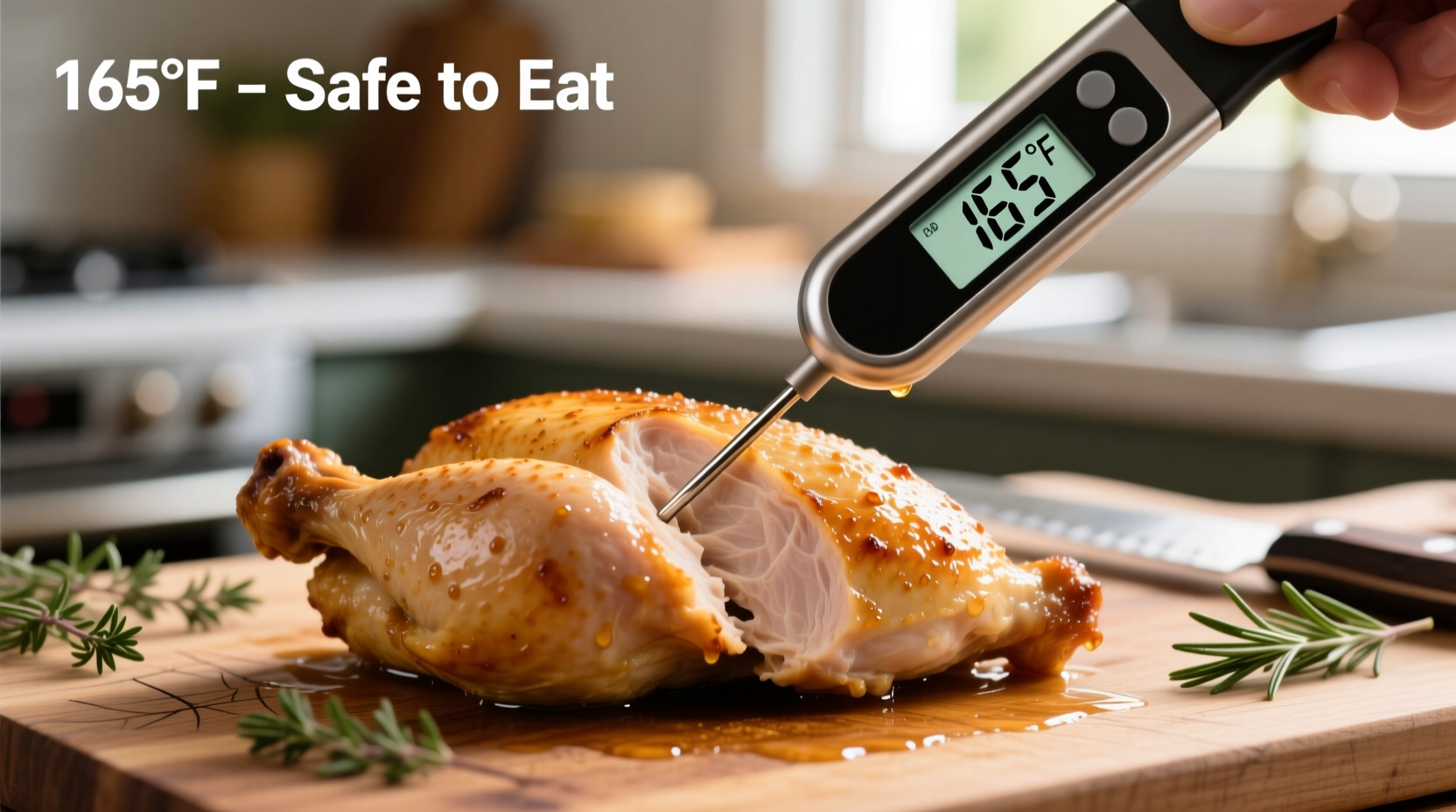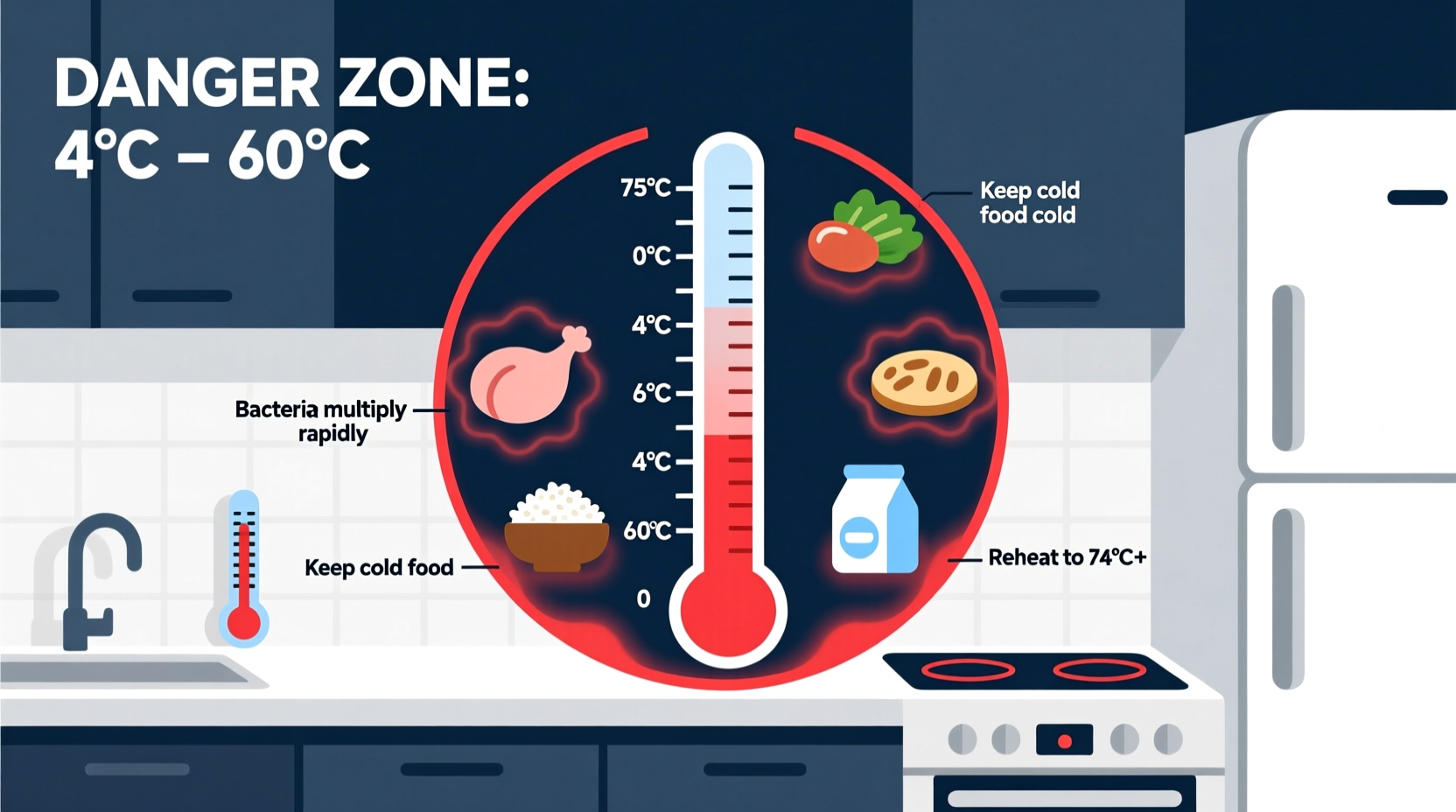Understanding food temperature safety isn't just for professional chefs—it's essential knowledge for anyone who handles food at home. When you know exactly what the danger zone for food temps is and how to avoid it, you're taking the most important step toward preventing foodborne illness in your kitchen. This guide delivers science-backed temperature guidelines you can trust, with practical strategies that work in real-world cooking situations.
What Exactly Is the Food Danger Zone?
The food danger zone represents the critical temperature range where pathogenic bacteria like Salmonella, E. coli, and Listeria thrive and multiply most rapidly. According to the USDA Food Safety and Inspection Service, this range spans from 40°F (4.4°C) to 140°F (60°C).
Within this zone, bacteria can double in number approximately every 20 minutes under ideal conditions. This exponential growth means that a small, harmless amount of bacteria can quickly reach dangerous levels that cause illness. The FDA Food Code specifies that food should not remain in the danger zone for more than two cumulative hours—and only one hour when ambient temperatures exceed 90°F (32°C).
| Temperature Range | Bacterial Growth Rate | Food Safety Status |
|---|---|---|
| Below 40°F (4.4°C) | Slowed significantly | Safe for storage |
| 40°F-140°F (4.4°C-60°C) | Rapid multiplication | Danger zone - avoid |
| Above 140°F (60°C) | Slowed or stopped | Safe for serving |
Why Temperature Control Matters: The Science Behind Bacterial Growth
Pathogenic bacteria require specific conditions to multiply, with temperature being the most critical factor home cooks can control. The danger zone represents temperatures where bacteria have optimal conditions for reproduction. At 70°F (21°C), bacteria might double every 30 minutes, but at 98.6°F (37°C)—close to human body temperature—they can double in as little as 10-20 minutes.
The Centers for Disease Control and Prevention reports that foodborne illnesses affect 1 in 6 Americans annually, resulting in 128,000 hospitalizations. Proper temperature management prevents these illnesses by interrupting the bacterial growth cycle before dangerous levels accumulate.

Practical Temperature Management: From Refrigeration to Serving
Knowing what the danger zone for food temps is means little without practical implementation strategies. Here's how to apply this knowledge throughout the food handling process:
Refrigeration and Freezing
Keep your refrigerator at or below 40°F (4.4°C) and your freezer at 0°F (-18°C). Use appliance thermometers to verify temperatures, as built-in dials are often inaccurate. The USDA recommends these maximum storage times for common foods:
- Raw poultry: 1-2 days
- Ground meats: 1-2 days
- Beef, pork, lamb roasts: 3-5 days
- Leftovers: 3-4 days
Cooking Temperatures That Beat the Danger Zone
Proper cooking temperatures destroy existing bacteria. Always use a food thermometer to verify internal temperatures:
- Poultry (chicken, turkey): 165°F (73.9°C)
- Ground meats: 160°F (71.1°C)
- Fish: 145°F (62.8°C) or until flesh flakes easily
- Beef, pork, veal, lamb steaks: 145°F (62.8°C) with 3-minute rest time
Cooling Cooked Foods Properly
Rapid cooling prevents bacteria from multiplying during the critical transition from cooking to storage. Follow these guidelines:
- Cut large portions into smaller pieces (e.g., divide a large roast into smaller chunks)
- Use shallow containers (no deeper than 2 inches)
- Place containers in an ice-water bath while stirring
- Cool food from 140°F to 70°F within 2 hours, then to 40°F within an additional 4 hours
Special Considerations and Context Boundaries
While the standard danger zone applies broadly, certain situations require adjusted temperature protocols:
- Commercial food service: The FDA Food Code requires more stringent time limits for food in the danger zone than home kitchens
- Vacuum-sealed foods: Some pathogens like Clostridium botulinum can grow at lower temperatures in oxygen-free environments
- Acidic foods: Foods with pH below 4.6 (like tomatoes) have a slightly higher danger zone threshold
- High-sugar foods: Jams and preserves may have different temperature safety profiles due to sugar's preservative effect
Essential Tools for Temperature Control
Accurate temperature monitoring requires the right tools:
- Digital instant-read thermometer: Essential for checking cooking temperatures (calibrate monthly)
- Appliance thermometer: Monitors actual refrigerator and freezer temperatures
- Thermocouple thermometer: For precise temperature monitoring during sous vide cooking
- Cooler thermometer: Critical for food safety during outdoor events and transportation
Remember that visual cues like color changes or texture aren't reliable indicators of food safety—only a properly calibrated thermometer provides accurate temperature readings.
Common Danger Zone Mistakes to Avoid
Even experienced cooks make these temperature safety errors:
- Leaving food out to cool at room temperature for extended periods
- Using the same thermometer for raw and cooked foods without proper sanitizing
- Assuming food is safe because it smells or looks fine (pathogens don't always affect appearance)
- Thawing food on the counter instead of in the refrigerator, cold water, or microwave
- Not accounting for carryover cooking when removing food from heat sources
Temperature Guidelines Evolution
Food safety temperature guidelines have evolved significantly based on scientific research. The current 40°F-140°F danger zone definition emerged from research conducted in the 1970s and 1980s. Previously, the lower boundary was considered 50°F, but studies showed significant bacterial growth could occur between 40°F and 50°F. The upper boundary was raised from 130°F to 140°F as research demonstrated more complete pathogen destruction at the higher temperature.
These evidence-based adjustments reflect our improved understanding of bacterial behavior and represent the current scientific consensus on food temperature safety.
Key Takeaways for Everyday Food Safety
Mastering what the danger zone for food temps means in practical terms transforms how you handle food. Keep these principles in mind:
- Use thermometers, not guesswork, for temperature verification
- Minimize time in the danger zone during every stage of food handling
- Understand that time and temperature work together—shorter time in the zone reduces risk
- When in doubt about food safety, throw it out—don't risk illness
By consistently applying these temperature safety principles, you'll significantly reduce the risk of foodborne illness in your home kitchen while maintaining the quality of your cooked foods.











 浙公网安备
33010002000092号
浙公网安备
33010002000092号 浙B2-20120091-4
浙B2-20120091-4